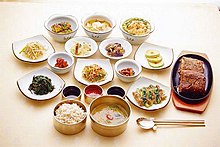food.wikisort.org - Dish
Yeot-gangjeong (엿강정) is a candy bar-like variety of hangwa (traditional Korean confection) consisting of toasted seeds, nuts, beans, or puffed grains mixed with mullyeot (rice syrup).[1][2][3] In general households, they usually make and eat yeot-gangjeong during Korean holidays and Jesa. Or, it is made and sold as a winter snack and is usually eaten during holidays and feasts.
 Ttangkong-yeot-gangjeong (peanut candy bar) | |
| Type | Hangwa Candy bar |
|---|---|
| Place of origin | Korea |
| Associated national cuisine | Korean cuisine |
| Main ingredients | Toasted seeds, nuts, beans, or puffed grains; mullyeot (rice syrup) |
| Korean name | |
| Hangul | 엿강정 |
|---|---|
| Revised Romanization | yeot-gangjeong |
| McCune–Reischauer | yǒt-kangjǒng |
| IPA | [jʌt̚.k͈aŋ.dʑʌŋ] |
 |
| This article is part of a series on |
| Korean cuisine 한국 요리 조선 료리 |
|---|
Preparation
Use pine nuts as they are, split peanuts in two, stir-fry sesame seeds, and perilla seeds, beans, and fry rice paste. Mix the ingredients prepared by melting sugar into honey and pour bean powder or oil on a large wooden or metal plate, spread it quickly when it is hot, and cut the wheat into the right thickness with the next knife.
Pine nut, sesame, walnut, and peanut yeot-gangjeong are made of diamond-shaped or corrugated patterns, and rice paste yeot-gangjeong are recommended to be rounded to the size of a tennis ball.[4]
Gallery
- Cutting yeot-gangjeong
- Black sesame yeot-gangjeong
- Black soybean yeot-gangjeong
- Peanut, puffed rice, and raisin yeot-gangjeong
- Puffed rice yeot-gangjeong
- Puffed rice and raisin yeot-gangjeong
- Sesame yeot-gangjeong
- Walnut yeot-gangjeong
See also
- Candy bar
- Dessert bar
- Gozinaki
- Sachima
References
- "Yeot-gangjeong" 엿강정. Doopedia (in Korean). Doosan Corporation. Retrieved 7 December 2009.
- Chun, Hui-jung (2004). Yoon, Ho-mi (ed.). Korean Food Guide 800. Seoul: The Korea Foundation. p. 170. ISBN 89-89782-10-4. Retrieved 18 August 2017 – via issuu.
- Kwon, Yong-Seok; Kim, Young; Kim, Yang-Suk; Choe, Jeong-Sook; Lee, Jin-Young (2012). "An Exploratory Study on Kwa-Jung-ryu of Head Families". Journal of the Korean Society of Food Culture (in Korean). 27 (6): 588–597. doi:10.7318/kjfc/2012.27.6.588. Retrieved 18 August 2017.
- "엿강정 - 한국민족문화대백과사전". Encyclopedia of Korea Culture. Retrieved 2021-04-17.
{{cite web}}: CS1 maint: url-status (link)
Другой контент может иметь иную лицензию. Перед использованием материалов сайта WikiSort.org внимательно изучите правила лицензирования конкретных элементов наполнения сайта.
WikiSort.org - проект по пересортировке и дополнению контента Википедии







